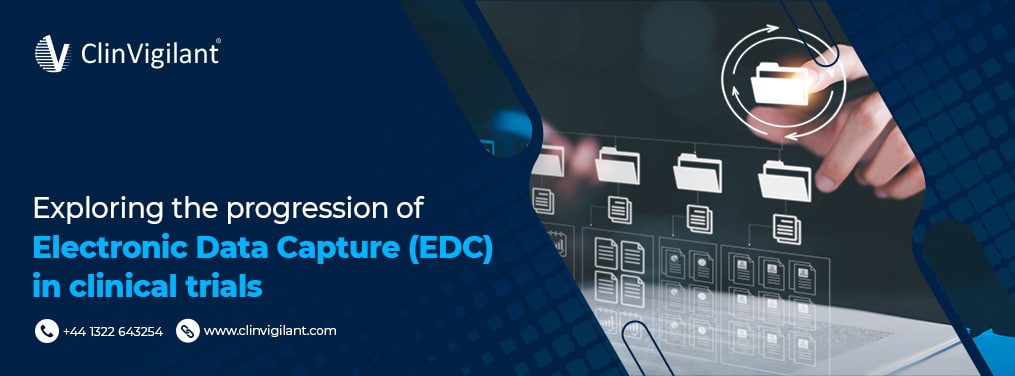
The way data is gathered, maintained, and evaluated has undergone a revolution as a result of the astounding technological developments that have occurred recently in the field of clinical research. One such innovation is the introduction of Electronic Data Capture (EDC) devices, which have fundamentally altered the clinical trial scene. This article explores the development of EDC in clinical trials, noting its advantages, difficulties, and potential.
The Role of EDC in Clinical Trials
The way data is gathered, maintained, and evaluated has been transformed by EDC technologies, which have made several important contributions to the clinical trial process. These are EDC’s main responsibilities in clinical trials.
1. Efficient Data Collection and Management:
EDC systems expedite the data-collecting procedure by enabling electronic patient data to capture right at the point of care. Due to the absence of paper-based case report forms (CRFs) and human data entry, there is a substantially lower chance of mistakes and inconsistent data. Researchers can create electronic case report forms (eCRFs) using EDC systems, including built-in data validation checks to ensure correct and comprehensive data submission. The electronic aspect of data collecting boosts effectiveness quickens data availability, and generalizes trial times.
2. Data Quality and Integrity:
Clinical trial data quality and integrity are improved because of EDC technologies. EDC platforms ensure that data entered into the system is correct, consistent, and compliant with preset validation standards through automatic data validation and edit checks. Data completeness, range checks, and logical constraints can all be enforced by EDC systems, which can also instantly indicate potential errors or inconsistencies. Because of the fast feedback provided, data input errors are less likely to occur, improving the trial data’s overall quality and dependability.
3. Real-Time Data Monitoring and Safety Alerts:
EDC systems enable real-time trial data monitoring, improving patient safety and allowing for quick action. Through automated data monitoring and safety alerts, EDC platforms can provide warnings based on established criteria, such as adverse event reporting, protocol deviations, or safety issues. In order to guarantee patient safety and regulatory compliance, researchers can quickly review and respond to these notifications. The proactive management of the trial is facilitated by real-time data monitoring, which enables changes to be made as necessary to treatment regimens, data collection techniques, or recruitment tactics.
4. Efficient Data Analysis and Reporting:
EDC systems make a substantial contribution to clinical trials’ effective data analysis and reporting. Since data are available in an electronic format, manual data extraction and modification are unnecessary for quicker data aggregation and analysis. Researchers can extract trial data in various formats for statistical analysis using the built-in data export functionalities that EDC platforms frequently provide. EDC systems may also create personalized and standard reports, which saves time and effort when preparing reports. EDC systems’ effective data analysis and reporting speed up the dissemination of trial results and aid in developing decisions supported by the best available evidence.
Benefits of EDC in Clinical Trials
Clinical trials have benefited greatly from electronic data capture (EDC) technologies, which have revolutionized how data is gathered, maintained, and evaluated. The following are the main benefits of using EDC in clinical research:
1. Efficiency and Time Savings:
EDC systems automate data collecting, doing away with the necessity for manual data entry and minimizing paperwork. At the point of care, researchers can electronically directly collect data, guaranteeing real-time data entry and minimizing the delay between data collection and availability. This shortens the duration of the trial as a whole and makes decision-making, data analysis, and reporting easier. EDC also eliminates the requirement for data transcription, which lowers the possibility of mistakes and cuts down on the time and work needed for data cleansing.
2. Data Quality and Integrity:
EDC systems incorporate built-in validation and edit checks to enhance data quality and integrity. These checks help minimize data entry errors and inconsistencies by ensuring that the data is correct, comprehensive, and consistent. EDC platforms can enforce Data validation criteria in real time, alerting data entry personnel to any errors or inconsistencies. Researchers can quickly fix any problems, resulting in high-quality and trustworthy data throughout the experiment. Data integrity and comparability between study sites are improved by adopting standardized electronic case report forms (eCRFs).
3. Real-Time Data Monitoring and Safety Alerts:
Real-time trial data monitoring made possible by EDC systems enables researchers to spot safety issues or negative outcomes quickly. EDC solutions are able to immediately initiate actions based on established criteria through automated notifications and safety alarms. This real-time data monitoring makes it possible to intervene at the right time and ensure that negative events are handled immediately, improving patient safety. In order to oversee and change trial activities proactively, researchers can continuously monitor study progress, data completion, and patient recruitment rates.
4. Enhanced Collaboration and Data Sharing:
EDC solutions make it easier for all parties participating in a clinical trial to work together seamlessly. No matter where they are physically located, researchers, site coordinators, and sponsors can access the study data instantly. This makes it possible for team members to communicate effectively and securely share data. In addition to on-site inspections, EDC systems enable remote monitoring, providing remote data review and query administration. Increased communication and data exchange support successful clinical trial oversight, encourage transparent decision-making, and stimulate efficient decision-making.
5. Regulatory Compliance and Auditing:
EDC systems incorporate features and functionalities that align with regulatory requirements to ensure regulatory compliance. To safeguard patient privacy and data integrity, EDC platforms can establish user access controls, impose data validation checks, and keep an audit trail of all data updates. The electronic form of data capturing makes it simpler to prepare and submit regulatory paperwork, which streamlines the inspection and auditing process. EDC systems also offer a central location for trial- and study-related documentation, which makes it easier to organize and retrieve documentation during regulatory inspections.
6. Cost Savings:
The use of EDC systems helps reduce the cost of clinical trials. EDC reduces the requirement for paper-based data gathering, which lowers the cost of paper CRF printing, shipping, and storage. EDC’s automatic data cleaning and validation processes save the time and money needed for manual data cleaning and query resolution. EDC systems provide remote data review and monitoring, which can dramatically save travel expenses and resource allocation. They also lessen the requirement for site visits and on-site monitoring.
Challenges of EDC Implementation in Clinical Trials
While electronic data capture in clinical trials offers numerous benefits in clinical trials, their implementation can pose several challenges that must be addressed. Understanding these challenges is essential to ensure the successful integration of EDC into clinical research processes. Here are some of the key challenges faced during EDC implementation:
1. Initial Investment and Infrastructure:
EDC system implementation necessitates a substantial upfront expenditure for infrastructure, hardware, and software licenses. It may be difficult for research institutions, especially smaller ones or those with low resources, to budget money for EDC implementation. For some firms, the expense of purchasing and maintaining the required technological infrastructure, including servers and databases, might act as a barrier to entry. To overcome these financial difficulties and guarantee a successful implementation of the EDC, adequate planning and budgeting is needed.
2. User Acceptance and Training:
Researchers, study coordinators, and other clinical trial staff may have a learning curve while switching from conventional paper-based procedures to EDC technology. Training and user acceptance are essential for the successful adoption of EDC systems. Employees must receive training on how to use the EDC software, navigate it, and enter data appropriately. Slower adoption rates and possible data entry errors might be caused by resistance to change or lack of experience with electronic systems. Users can be helped to overcome these difficulties and ensure a seamless adoption by receiving thorough training and ongoing assistance.
3. Data Security and Privacy:
Data security and privacy are paramount because EDC systems handle delicate patient data, including private health information. To preserve patient privacy, it is essential to ensure adherence to legal requirements such as the General Data Protection Regulation (GDPR) and the Health Insurance Portability and Accountability Act (HIPAA). To protect data from unauthorized access or breaches, EDC systems must have strong security mechanisms like as encryption, access limits, and audit trails. Data security and privacy policies should be given top priority by organizations employing EDC, and systems should be updated often to handle new threats and vulnerabilities.
4. Integration with Existing Systems:
Integrating EDC systems with already-in-use clinical trial management systems (CTMS), electronic health records (EHR), and other data sources can be challenging. To ensure seamless data flow and reduce duplication or discrepancies, data interchange, and interoperability between various systems must be properly planned and implemented. Differences in data formats, system compatibility issues, or organizational policies can all cause integration problems. Working together with IT professionals and conducting in-depth system testing and validation can assist in solving integration problems and guarantee effective data management across many platforms.
5. Regulatory Compliance:
EDC adoption in clinical trials must follow the rules and regulations established by regulatory organizations like the European Medicines Agency (EMA) and the Food and Drug Administration (FDA). Meeting regulatory compliance can be difficult, especially for firms doing trials across several countries or regions with various regulatory frameworks. To meet regulatory requirements, EDC systems must collect the relevant data points, provide the requisite checks and validations, and maintain data integrity. EDC adoption may be complicated further by recurring audits and inspections to ensure compliance.
6. Limited Technology Literacy:
In some circumstances, clinical trial participants, site employees, or even investigators may lack technology literacy. Lack of experience with electronic devices, laptops, or cell phones can make acquiring and using EDC effectively difficult. Training programs and user-friendly interfaces should accommodate users with different degrees of technological proficiency. This problem can be solved by offering detailed instructions, user guides, and continuing technical assistance. This will guarantee that all stakeholders can use the EDC system efficiently.
Conclusion
Clinical trial data collection, management, and analysis have all been revolutionized by electronic data capture (EDC), which has achieved tremendous advancements in this area. EDC systems have many advantages, such as improved productivity, high-quality data, and regulatory compliance. The future of EDC appears bright despite certain implementation difficulties, with prospective developments like EHR integration, mobile technology use, and AI-driven analytics. EDC is positioned to play an increasingly important role in determining the direction of clinical trials as the field of clinical research continues to embrace technology advancements.

